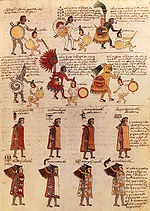



A tilmàtli (or tilma; Classical Nahuatl: tilmahtli, IPA: [tilmaʔtɬi]) was a type of outer garment worn by men as a cloak/cape, documented from the late Postclassic and early Colonial eras among the Aztec and other peoples of central Mexico.
Styling
The garment was to be worn at the front like a long apron, or alternatively draped across the shoulders as a cloak. It was also frequently used as a carry-all.
Significance
Several different types of the garment were in use, designed for the various classes in society. Upper classes wore a tilmàtli of cotton cloth knotted over the right shoulder, while the middle class used a tilmàtli made of ayate fibre, a coarse fabric derived from the threads of the maguey agave. It was knotted over the left shoulder. The lower classes knotted the garment behind the neck, where it could serve for carrying.

a: a young person wearing only a maxtlatl
b: a common person (Macehualtin) dress
c: a noble (Pipiltin) or high ranking warrior dress
d: dress of the ruling classes and the clergy
e: a less common way to wear the tilmàtli
f: war dress.
Miraculous image

A very famous tilmàtli was that worn by Juan Diego in 1531; according to tradition, an image of the Virgin Mary appeared on it in the presence of the bishop of Mexico City. The image is preserved in the Basilica of Our Lady of Guadalupe which attracts millions of pilgrims annually.
Notes
- Handbook to Life in the Aztec World by Manuel Aguilar-Moreno, Facts on File, New York, 2006
- The Essential Codex Mendoza by Frances F. Berdan and Patricia Rieff Anawalt, University of California Press, London, 1997
- See Johnston (1981).
References
- Johnston, Francis (1981). The Wonder of Guadalupe : The Origin and Cult of the Miraculous Image of the Blessed Virgin in Mexico. Rockford, Illinois: Tan Books and Publishers. ISBN 0-89555-168-3.